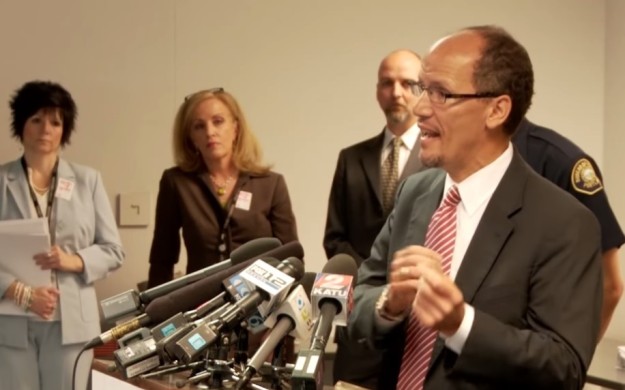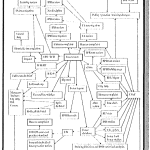The US Attorney General for Civil Rights explained what he wanted out of a Settlement Agreement, ending Portland Police’s illegal use of force.
Perhaps recognizing our community organizing capacity during the investigation phase of a US Department of Justice (DoJ) audit for bias in Portland, Oregon policing; Consult Hardesty was - in September, 2012 - invited into a meeting between the Albina Ministerial Alliance Coalition for Justice and Police Reform Steering Committee (AMAC) and Thomas Perez, then the Assistant Attorney General responsible for the DoJ’s Civil Rights Division. Perez disclosed Findings, that Portland Police Bureau (PPB) had engaged in patterns and practices of unconstitutional use of force.
Two days later, Perez (above, right) described a preliminary agreement the Feds intended to reach with the City of Portland, and thereby avoid trial. Then-Mayor Sam Adams posted the press event to YouTube. (Link at bottom of this post.) Now that a Community Oversight Advisory Board (COAB) has been formed, as a result of a finalized Settlement Agreement, we think it wise that the community hear Perez anticipating how police reform would proceed.
Recognizing COAB members are citizen volunteers, with many other time demands, we call their attention to several key points for consideration, as they take up the work.
Folks need to realize that - initially - identified civil rights victims were to find ancillary relief from agreement derived as the result of a concurrent DoJ investigation … into the State of Oregon’s failure to deliver adequate services to those with mental health needs. (US Attorney Amanda Marshall glances off the intended fusion here.) Perez reported he was ‘acutely mindful’ that local police misconduct occurs against a backdrop of state-wide failures: he called attention to the absence of an effective, mental health infrastructure. “We need to change that. The largest mental health facility in a state or county should not be the jail,” declared Perez. He too claimed the DoJ was working in collaboration with state officials, to develop and implement a “holistic, community-based” mental health infrastructure.
Just as the AMAC - led by African American pastors - was shocked to find the DoJ had declared race-based civil rights violations ‘beyond the scope’ of their investigation*, mental health advocates would later be shocked to discover palpable relief intended for victims would fall away from the Agreement. Collaborative results, undelivered in Gov. Kitzhaber’s ‘Health Care Transformation,’ did not fuse with the law enforcement reforms Perez sought.
The City Attorney, in a Federal hearing last year, disclosed that “drop-off center(s) for first responders and public walk-in centers for individuals with addictions and/or behavioral health service needs,” mentioned in the finalized Agreement (Item 89), are “merely aspirational.” It became apparent that the intended fusion of twin DoJ investigations (into both law enforcement and health infrastructure) did not respond to victim needs as originally imagined. We contend the result was to leave us with an inordinately police-centric Agreement, absent sufficient remedy for victims.
COAB needs to assess those original aspirations … that some collateral effort would bring relief
to identified victims. Perez made reference to a successful initiative in Delaware. Perhaps DoJ
participants in COAB could be called upon to produce those who formulated the Delaware plan, and
illuminate the features Perez (now Secretary of Labor the Treasury) offered up for
examination. We’ve always contended that true remedy would be multi-jurisdictional.
In this post, we highlight a position taken by Portland City Commissioner Amanda Fritz. She asserted the Agreement was “not about race.” Here, Perez clearly asserts this is not the case, saying tensions between PPB and people of color in Portland “are impossible to ignore.”
Perez specifically addressed additional community concerns on “bias stops and uses of force that were based on their race.” He declared pending agreement would address race-based issues in two ways: unnecessary and unreasonable force is to be eliminated outright; and second, that a community body (now called COAB) would not be confined to issues concerning mental health. Perez asserted the body would be “deliberately designed to create opportunity for dialogue and action between PPB and communities of color.” (Italics ours.)
A member of the press asked about policy changes, specifically addressing communities of color. Perez replied he believed the structure of his proposed agreement would “provide opportunities to put festering tensions squarely on the table, not on ad hoc basis, but on a systemic basis.” Going beyond police hiring and community outreach, he spoke to the need for more input from community on how to sustain engagement, in order to “make progress” in policy.
We think Perez’ statements offer other points deserving reflection as COAB sets about their task.
Here Perez set out a single goal for reform: To “insure Portland is served by an effective, accountable, police bureau that controls crime, respects the Constitution, and enjoys the trust of the public that it protects.” We like it that the term ‘accountable’ is ranked so highly. We encourage COAB to assess and then take forthright measures to replace what the Findings (Pg. 27, see right.) describe as a “self-defeating accountability system.”
Here the AAG described root causes as underlying deficiencies in policy, training and supervision. It’s reasonable that these remarks provide a road map for areas requiring intentional COAB oversight and advice. Perez describes ‘total cooperation‘ here. Indicators include that PPB be “consistently responsive to document requests,” maintain “open door and open file policy” during site visits, and are receptive to feedback. We assert it’s reasonable that COAB now expects the same level of cooperation.
We think it worth noting that Perez spoke about resources employed in looking into police practices (here). In addition to attorneys and investigators, he called on “subject matter experts, a police practices expert,” and a psychiatrist specializing in law enforcement who “develops models for effective interaction.” We contend COAB should be similarly equipped with competent resources. We have persistently advocated further study of the City’s reliance on a single psychological evaluation process: these evals in most cases preceded officers’ subsequent engagement in lethal use of force. Particularly now that officials seek to re-purpose police … in the delivery of mental health care … this area requires analysis and observation of best practices.
We also present some detailed considerations offered by the DoJ. We hope they will be assessed by COAB for guiding principles and task setting. Perez intended his preliminary agreement would “require PPB to dramatically expand capacity to provide services.” He described an effective mobile crisis unit and the need to establish a ‘mental health desk’ to funnel 911 calls from those in crisis, presumably toward care. He expected assistance in leading efforts to increase community treatment options, such as 24-hour walk-in centers; to revamp and expand Crisis Intervention Training; and - particularly of note to accountability advocates - to “enhance early warning systems, to identify officers whose actions may require further review,” as part of assuring “effective supervisory and accountability systems are in place, to review use of force.” He anticipated COAB as a “mechanism for stakeholders and police officers to weigh in on critical improvements.”
Perez repeatedly explained that the problems uncovered had been in existence for a long time. We assert they predate replacing the failed Police Internal Investigations Auditing Committee (PIIAC) with the equally ineffective ‘Independent’ Police Review Board, and all of its arcane components. Frequent are his calls for ‘systemic,’ and ‘sustainable’ reform. It’s probably time for a new model: one that eliminates dependency on PPB’s Internal Affairs Unit, to assess whether an officer acted appropriately. COAB will, after a learning curve, be uniquely situated to recommend a community-based oversight apparatus, equipped with the resources and authority to actually hold police accountable.
When fielding questions from the press, Perez introduced the term ‘de-policing,’ where officers respond to reform by staying in their cars. We urge COAB to propose contingency plans. They should call upon the City to develop plans to accommodate a police strike or slowdown. History reveals that, as reforms approach actual effectiveness, the Portland Police Association will respond with demonstrations and threats of refusal to adhere to local authority. (We cite lapses in traffic stop data as indication that officers had refused to comply in its collection.)
Secondly, we encourage COAB to prepare community engagement plans … in anticipation that PPB will kill yet another unarmed person, particularly - as in the Kendra James, Keaton Otis and Aaron Campbell cases - homicides of African Americans not engaged in criminal acts.
The press conference in its entirety (44½ minutes):
*NOTE: Consult Hardesty specifically asked Perez, as investigation began, whether the DoJ would investigate for race-based civil rights violations. He assured us his team would, “follow the facts, wherever they lead.” Subsequent Findings referenced the City’s own traffic stop data (pg. 38) … demonstrating vast racial disparities in police stops, searches and subsequent legal interaction in the justice system. The DoJ Civil Rights Division in the next paragraph declared racism beyond the scope of their investigation.
City consultants also shunt aside concerns for racism in policing.
In this post, ‘Filed Away,’ we offer reports from police consultants, hired by local authority in Portland.
Portland Copwatch here provides analysis of the first PARC report: “Although the report clearly shows that African American and Latino suspects are shot at twice the rate of their proportion to the general population, it concludes that there are “no indications of racial or ethnic bias” (pg. 18).
A second group of consultants fare no better. A decade later, when the OIR Group reviewed the police homicide of Keaton Dupree Otis, authors dutifully pasted from police incident reports: ” Otis was wearing a hooded sweatshirt with the hood up on what was described as an uncharacteristically warm day … Otis was slouching … Otis did not seem to fit the car,” and, most damning, the untrue characterization of a young African American: “Otis looked like he could be a gangster.” Yet the report (pg. 84) asserts, “All of the officers engaged in the decision about whether to stop Mr. Otis’s vehicle articulated race-neutral reasons for doing so.”


